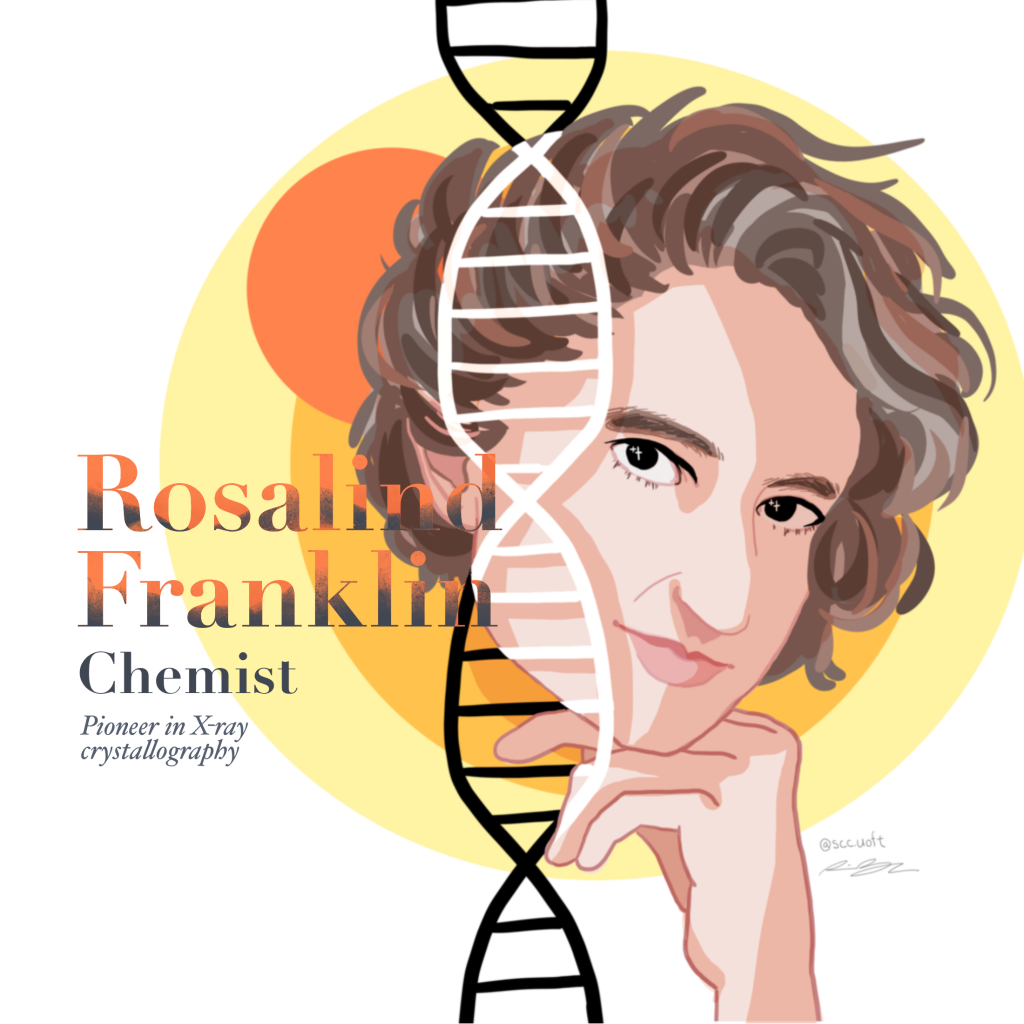
Written by Quinn Lui
Illustrated by Prima Zhao
Sometimes called the Dark Lady of DNA, Rosalind Franklin (1920–1958) was a prolific researcher in multiple scientific fields. She’s best known for her contribution to discovering DNA’s structure—as well as the controversy surrounding it.
Franklin, who was born to an influential British Jewish family, always excelled at school and decided to pursue a career in science at the ripe age of fifteen. Determined as she was, she got a degree in natural sciences from Newnham College at the University of Cambridge despite her father’s initial reluctance, going on to study the porosity of coal for her doctorate.
Franklin later focused on x-ray crystallography: analyzing the way a crystal causes an x-ray beam to diffract, or bend, then using that information to figure out the crystal’s atomic structure. In 1951, she took her expertise to King’s College, which had pioneered the use of x-ray diffraction techniques on biological material, but the College’s restrictions on women as well as miscommunication about Franklin’s responsibilities at the lab created a very tense and inefficient work environment.
But she didn’t let that stop her! Despite these setbacks, Franklin was able to contribute significant advances to DNA research. Soon after arriving at the college, she realized that DNA could exist in two forms, and she went on to figure out DNA’s density as well as correctly theorize about the placement of the different components on its structure. She was coming close to solving DNA’s structure once and for all!
At the same time, Jim Watson and Francis Crick had also been looking at the possibility of DNA having a double helix shape: two strands of DNA winding around each other, with elements connecting the strands in ladder-like rungs. But they were missing evidence to support this theory. So, without her knowledge, they managed to obtain an uncommonly clear x-ray photograph from Franklin’s lab, along with her unpublished observations based on x-ray crystallography, allowing them to complete their model. But despite her research playing a critical role, Watson and Crick’s work was published as their discovery alone; Franklin’s research was released as merely supporting data and she received no credit.
In 1953, Franklin left King’s College to study the tobacco mosaic virus at Birkbeck College. Though not directly related to DNA, this research still allowed her to contribute even further to the scientific community’s understanding of the double helix form. While at Birkbeck, Franklin published seventeen papers in total, with three appearing posthumously. She continued working until only weeks before her death from ovarian cancer.
Franklin’s legacy took a long time to come to light. Her tombstone only references her research on viruses, and neither Watson nor Crick mentioned her name while accepting their 1962 Nobel Prize for their work on DNA. Crick did eventually acknowledge in a letter that the data allowing his part in the ultimate discovery of DNA’s structure had been primarily obtained by Franklin. However, ironically, it was Watson and his incredibly unflattering portrayal of Franklin in his book, The Double Helix, who first publicly acknowledged the true extent of her contribution.
Over time, alternate depictions of Franklin’s character emerged thanks to her family and friends. Feminist interpretations of her situation spread and her name serves to inspire young girls interested in studying science. Today, she’s known as a brilliant scientist with a strong personality whose work remains crucially important to our understanding of how DNA works today.
Sources:
- Elkin, L. (2003). Rosalind Franklin and the Double Helix. Physics Today, 56(3), 42. https://doi.org/10.1063/1.1570771
- Glynn, J. (2008). Rosalind Franklin: 50 years on. Notes and Records of the Royal Society of London, 62(2), 253–255. https://doi.org/10.1098/rsnr.2007.0052
- https://www.newscientist.com/people/rosalind-franklin/
- Piper, A. (1998). Light on a dark lady. Trends in Biochemical Sciences, 23(4), 151–154. https://doi.org/10.1016/S0968-0004(98)01194-3
- https://profiles.nlm.nih.gov/spotlight/sc/catalog/nlm:nlmuid-101584582X67-doc
- https://www.theguardian.com/science/2015/jun/23/sexism-in-science-did-watson-and-crick-really-steal-rosalind-franklins-data